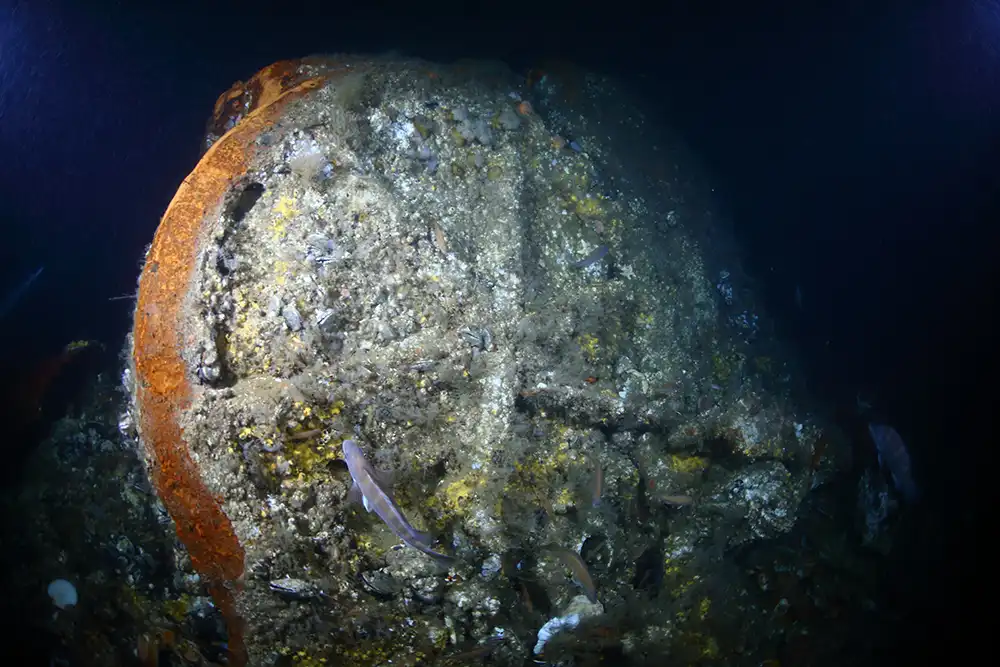
The wreck of Le Lyonnais, a sail-and-steam passenger ship that sank in 1856 with the loss of 114 lives, has been discovered some 200 miles off the coast of Nantucket, Massachusetts, by a team from Atlantic Wreck Salvage (AWS).
Le Lyonnais was built in 1855 by Laird, Son & Co (now Cammel Laird) in Birkenhead, UK for the Compagnie Franco-Americaine, based in Paris, France, one of six ships to be used for transatlantic passenger and mail services between Le Havre in France and North and South America.
Built during the mid-nineteenth century when ocean-going ships were making the transition from steam to sail, the 82.9m (272ft)-long vessel was fitted with both sails and a steam engine. She was also an early example of a passenger liner equipped with an iron hull and screw propeller – a very recent innovation at the time.
Le Lyonnais was launched in January of 1856 and made two trips to Rio de Janeiro before making her first crossing between Le Havre and New York in October 1856. On the night of 1-2 November, shortly after leaving New York harbour for the return voyage, however, she collided with Adriatic, a three-masted barque en route from Belfast, Maine, to Savannah, Georgia.

Adriatic kept going, its captain apparently unaware that Le Lyonnais had been severely damaged, while the wounded French ship remained under power for around 10 minutes before the fires under her boiler were extinguished by the water she was taking on from a hole near the waterline of her hull.
Attempts were made to bail her out and plug the hole with mattresses and quilts, but rough seas hampered the efforts. Meanwhile, passengers and crew built a raft out of spare masts and doors, as it became clear that Le Lyonnais ‘ lifeboats were not sufficient to hold everyone on board.
When it became inevitable that Le Lyonnais would sink, the crew and passengers boarded the lifeboats and the raft. They managed to stay together for a few hours until a thick fog set in, after which they separated and – with the exception of one boat under the command of Le Lyonnais‘ second mate – were never seen again.
Two of the lifeboat’s crew died during a week of rough seas and freezing weather, before the 16 remaining on board – five passengers and 11 crew – were rescued by the crew of a German barque, Elise, on its way from Baltimore to Bremen.
Adriatic and her crew, damaged but unharmed, sailed to Gloucester, Massachusetts for repairs.

Shipwreck hunter Captain Eric Takakjian first began searching for Le Lyonnais in the late 2000s, before Captain Joe Mazraani and Jennifer Sellitti of AWS exploration vessel, DV Tenacious, took up the reins of the search in 2016, spending the next eight years working with Takakjian to locate the steamer’s final resting place.
After interviewing fishermen who work in the area, some 200 miles off the Nantucket coast, the team used side-scan sonar to analyse potential targets in 2022 and 2023. After narrowing the field of candidates, DV Tenacious and her crew returned to the search area in August 2024, and made a total of thirteen dives to measure and take photographs and videos of the wreck.
The team reviewed the data and made a preliminary identification based on the ship’s size, location, iron plating, an examination of her portholes, and the presence of its unique type of steam engine.
‘One of the large cylinder heads pointed horizontally and not very high off the sand. Measuring that cylinder with my good friend and dive partner Tom Packer, we confirmed that it measured precisely 57 inches, the exact size for the cylinders on Le Lyonnais’ engine,’ said Mazraani.
‘On a subsequent dive, I spotted a deadeye – a wooden block used in a ship’s rigging system. Those clues with the location, sonar data and measurements, further solidified that we were diving the lost French liner.’

The wreck lies in an area known as Georges Bank, a large area of raised sea bed between Cape Cod, Massachusetts and Cape Sable Island in Nova Scotia, Canada, approximately 200 miles from the Massachusetts coast. The AWS team is not currently revealing Le Lyonnais’ exact location or depth, as they intend to return to the site to further explore and document it.
‘Being one of the first French passenger steamships to have a regularly scheduled run crossing the Atlantic and an early transitional steamship make Le Lyonnais’ discovery significant,’ said Takakjian of the find.
‘Her iron hull construction methods represented some of the earliest examples of that type of hull construction for oceangoing ships known to exist. Similarly, her propulsion machinery is unique in that it represents one of several engine designs that were tried before precedents were set on ocean steamship machinery.
The history of Le Lyonnais‘ sinking and the search for her whereabouts will be extensively documented in a forthcoming book by team member Jennifer Sellitti, who said she became ‘obsessed’ with the ship and its story after Mazraani suggested it to her as a project to look into.
‘Le Lyonnais, her passengers, and her story captivated me and set me on an eight-year journey in search not only of her final resting place but also for the truth behind her sinking and its eventful aftermath,’ said Sellitti. ‘Marking that journey with a book and collaborating with my friends on such an important discovery still feels surreal.’

The Adriatic Affair: A Maritime Hit-and-Run Off the Coast of Nantucket (Schiffer Publishing, $34.99/£31.99 Hardcover) is due to be published on 28 February 2025, and is available for pre-order from Amazon and other booksellers.
Related links:
- Wreck of British WWI liner SS Arcadian identified in Aegean Sea
- Treasures, Shipwrecks and the Dawn of Red Sea Diving, by Howard Rosenstein
- Mortar Wreck: grave slabs recovered from oldest British shipwreck
- Bell of WWI shipwreck, USS Jacob Jones, recovered
- First report from 2024 expedition to wreck of the San José
- Mantas and devil rays receive maximum CITES protection - 28 November 2025
- Oceanic whitetips uplisted to CITES Appendix I - 27 November 2025
- Florida diver dies on Key West’s Vandenberg wreck - 24 November 2025


